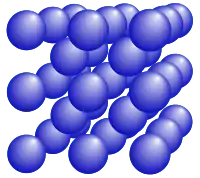 35 points in a body-centered cubic lattice, forming two cubical layers around a central point. | |
| Total no. of terms | Infinity |
|---|---|
| Subsequence of | Polyhedral numbers |
| Formula | |
| First terms | 1, 9, 35, 91, 189, 341, 559 |
| OEIS index |
|
A centered cube number is a centered figurate number that counts the number of points in a three-dimensional pattern formed by a point surrounded by concentric cubical layers of points, with i2 points on the square faces of the ith layer. Equivalently, it is the number of points in a body-centered cubic pattern within a cube that has n + 1 points along each of its edges.
The first few centered cube numbers are
Formulas
The centered cube number for a pattern with n concentric layers around the central point is given by the formula[1]
The same number can also be expressed as a trapezoidal number (difference of two triangular numbers), or a sum of consecutive numbers, as[2]
Properties
Because of the factorization (2n + 1)(n2 + n + 1), it is impossible for a centered cube number to be a prime number.[3] The only centered cube numbers which are also the square numbers are 1 and 9,[4][5] which can be shown by solving x2 = y3 + 3y , the only integer solutions being (x,y) from {(0,0), (1,2), (3,6), (12,42)}, By substituting a=(x-1)/2 and b=y/2, we obtain x^2=2y^3+3y^2+3y+1. This gives only (a,b) from {(-1/2,0), (0,1), (1,3), (11/2,21)} where a,b are half-integers.
See also
References
- ↑ Deza, Elena; Deza, Michel (2012), Figurate Numbers, World Scientific, pp. 121–123, ISBN 9789814355483
- ↑ Lanski, Charles (2005), Concepts in Abstract Algebra, American Mathematical Society, p. 22, ISBN 9780821874288.
- ↑ Sloane, N. J. A. (ed.). "Sequence A005898". The On-Line Encyclopedia of Integer Sequences. OEIS Foundation.
- ↑ Stroeker, R. J. (1995), "On the sum of consecutive cubes being a perfect square", Compositio Mathematica, 97 (1–2): 295–307, MR 1355130.
- ↑ O'Shea, Owen; Dudley, Underwood (2007), The Magic Numbers of the Professor, MAA Spectrum, Mathematical Association of America, p. 17, ISBN 9780883855577.